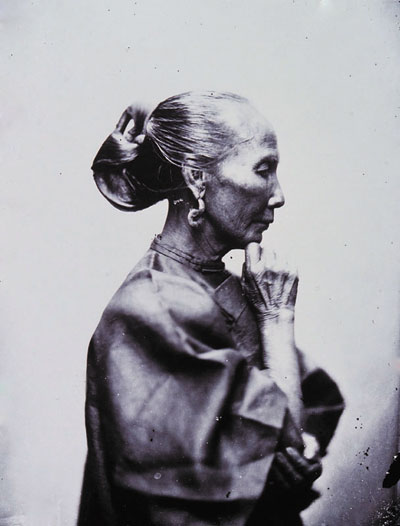
Cao Zhen
caozhen0806@126.com
CHINA’S rapid development makes the country of today almost unrecognizable from that of 150 years ago. Before imperial China disappeared forever, John Thomson (1837-1921), a Scottish pioneer in photojournalism and one of the most influential photographers of his generation, used his camera to document the country’s landscape, architecture, people and customs.
A vast collection of photos taken by Thomson in China from 1868 to 1872 is on display at the Shenzhen Museum, offering a window into a time of men with braids and women with bound feet. Wellcome Collection Library in London, England is providing the exhibit’s 159 prints. Unlike most blurry, century-old photos, the exhibits are high-definition scans, some of which are enormous in size.
Born in 1837, two years before the invention of the daguerreotype and the birth of photography, Thomson was one of the first photographers to travel to the Far East. Trained as an optical and scientific instrument manufacturer in Edinburgh, Thomson moved to Singapore in 1862, where he set up a photography studio. He traveled widely around Malaya, Siam and Cambodia and captured images of Angkor Wat and the King of Siam, who is best known as “the King” in the famous Western musical “The King and I.”
Fascinated by Eastern cultures, Thomson settled in Hong Kong in 1868, setting up a photography studio on Queen’s Road Central, and spent the next four years traveling to Guangdong, Fujian, Shanghai, Beijing and around the Yangtze River region, photographing local people and recording the diversity of Chinese culture.
“Thomson came to China after the Second Opium War, a war pitting the British Empire and the Second French Empire against China’s Qing Dynasty from 1856 to 1860,” explained Betty Yao, curator of the exhibition. “At a time when Chinese people hated Westerners, intrepid Thomson won the confidence of Chinese people from all walks of life through his friendly personality.” Yao is the director of London-based Credential International Arts Management.
“Thomson didn’t understand Chinese, so he normally let his Chinese-speaking Western friends serve as interpreters. Living in an unfamiliar country, he was an open-minded and brave person,” said Yao.
Unlike most Westerners in the late Qing Dynasty who were missionaries, Thomson was a professional photographer, so he was sensitive to the lives and surroundings of his subjects. In Thomson’s 650 photographs of imperial China, he portrayed everyone from humble street vendors and fisherwomen to rich brides and powerful imperial rulers. He produced a wonderful historical record of Chinese lives as well as iconic landscapes including sedan chairs, temples and the South China Sea.
Among the striking photos of Chinese people, portraits of women are especially stunning. “These photos of past women still look fashionable today,” said Yao. “Although they were feudal women, their poses were very modern. I think Thomson told them how to strike a pose for his photos. You can see the differences in hair ornaments between Cantonese and Beijing women and the difference in outfits between the poor and the rich. You can even sense the relaxed facial expression from a poor boatwoman and the unease in a rich bride’s eyes,” said Yao.
Thomson wrote annotations on each of his glass negative plates, which are valuable for modern scholars’ research on Chinese history. From his annotations, Thomson showed his respect for the hardships and toughness of poor people, his fascination of the elegant and richly colored dresses of Manchu ladies, and his fondness of Cantonese boatwomen, saying they were the prettiest women he had come across in China.
Chinese street life occupied a central place in Thomson’s work, which was described by him as “highly picturesque and interesting.” He also regarded himself extremely lucky for being admitted into imperial courtyards, describing them as “the sacred precincts of the mysterious Chinese dwelling.” He said he had opportunities to gain some insights into the daily lives of the Chinese, from beggars to rulers.
Thomson’s adventures are remarkable enough in themselves, but the story of how he took the clear photos is equally extraordinary. At the Shenzhen exhibition, a bilingual video shows Thomson’s “wet-collodion” photography process.
In Thomson’s era, negatives were made on glass plates that had to be coated with emulsion before exposure. The wet-collodion photography presented desirable qualities, creating a sharpness and clarity. But it also had disadvantages. The entire process, from coating to developing, had to be done before the plate dried. This gave the photographer no more than 10 minutes to complete everything.
“Since Thomson had learned the principles of photography in Edinburgh, the wet-collodion process was not a problem for him. The biggest challenge was the heavy and bulky photographic equipment, including hundreds of glass plates and a cumbersome portable darkroom. Thomson had to add both perseverance and physical strength to his enthusiasm for exploring China,” said Yao.
After Thomson died, all 650 glass negative plates were sold to the Wellcome Collection Library by his son. In 2008, the glass negatives were scanned into enormous digital files and high-resolution inkjet prints were produced.
Dates: Through May 20
Hours: 10 a.m.-6 p.m. Closed Mondays
Venue: Shenzhen Museum, Block A, Civic Center, Futian District (福田区市民中心A区深圳博物馆新馆)
Metro: Shekou or Longhua Line, Civic Center Station (市民中心站), Exit B
|

